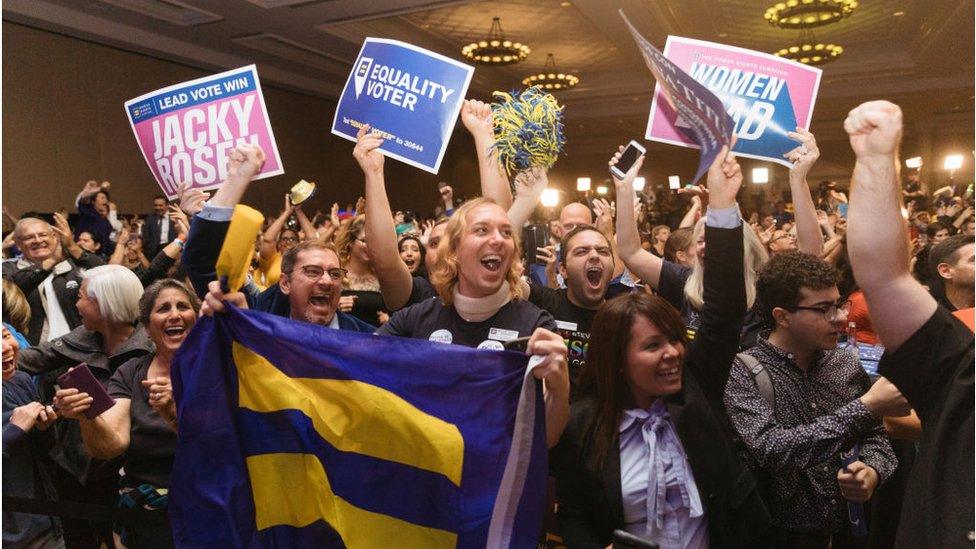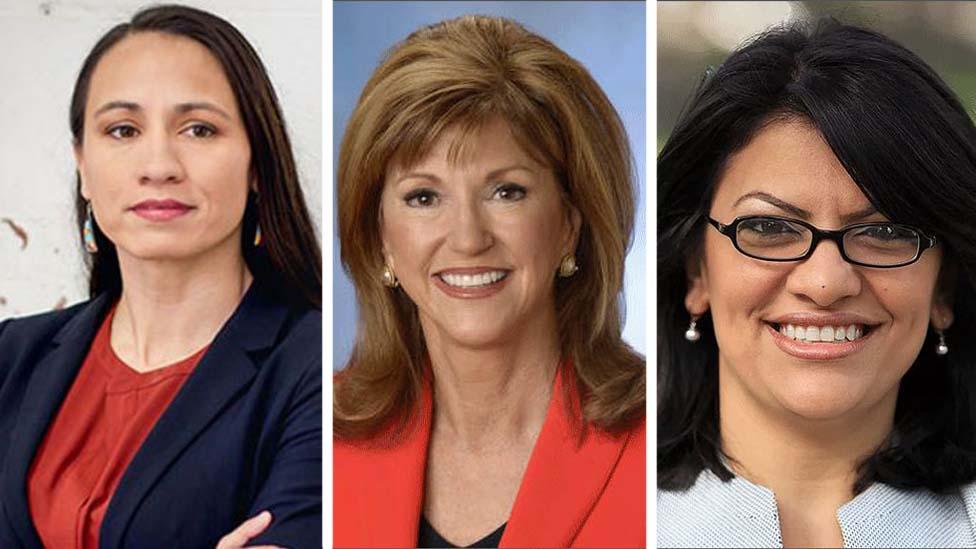Nevada makes history with first female-majority legislature
- Published

With wins during the mid-term elections and these new appointments, Nevada now has the highest percentage of female lawmakers nationwide
Nevada has become the first state in the US with a female-majority legislature, where women hold 51% of seats.
On Tuesday, Democrats Rochelle Nguyen and Beatrice Duran were appointed to the assembly, replacing lawmakers who had moved on from their posts.
Of Nevada's 63 legislative seats, 32 are now filled by women.
The historic moment follows an election season that saw an unprecedented number of women win congressional seats.
Former Secretary of State and presidential candidate Hillary Clinton tweeted about the milestone, external, saying: "Let's make it the first of many."
Before the last month's mid-term elections, 38% of Nevada's legislative seats were held by women.
Women won seats during the mid-terms, but secured the majority only with Tuesday's appointments.
In the assembly, women have a majority with 23 of 42 assembly seats. In the Senate, women hold nine of 21 seats.
Ms Nguyen, a criminal defence lawyer, replaced Chris Brooks, who won a Senate seat in November. Ms Duran, a union grievance specialist, replaced Olivia Diaz who is running for a Las Vegas city council seat.
Both received unanimous appointments.
Allow Facebook content?
This article contains content provided by Facebook. We ask for your permission before anything is loaded, as they may be using cookies and other technologies. You may want to read Meta’s Facebook cookie policy, external and privacy policy, external before accepting. To view this content choose ‘accept and continue’.

They will both be a part of a Democratic supermajority in the assembly, with the party holding 29 of 42 seats.
Ms Duran told the Associated Press, external that the milestone was "a great victory" for women; Ms Nguyen said it was "fantastic".
Nevada now has the highest percentage of female lawmakers, ever, nationwide, at 47.6%. The state's Supreme Court is also female-led.
Following the elections, the state will now also have two US women senators, Democrats Jacky Rosen and Catherine Cortez Masto.
And it is sending a new female lawmaker, Susie Lee, to the US House of Representatives.
The women who made history in the mid-terms
Many have dubbed 2018 the second Year of the Woman given the number of female candidates running for office and winning seats during the 6 November mid-terms.
But while the number of women in state legislatures has more than quintupled since the 1970s, women account for only around 28% of state lawmakers nationwide, according to the National Conference of State Legislatures, external.
Debbie Walsh, Director of the Center for American Women and Politics (CAWP), told the BBC that change has been slow thanks to a "stagnation" in the numbers of female candidates.
"We know that when women run, they win at about the same rate as men. The problem hasn't been women not winning, it's been women not running."
In 2009, women briefly held the majority in New Hampshire's state Senate, but no state has ever had an evenly split legislature, let alone a female-majority.
This year, women took the majority in Colorado's state House as well, but only Nevada reached an overall legislative majority.
"A record number of candidates [this year] has resulted in a record number of women serving - not just nationally, but some of these breakthroughs like Nevada and Colorado," Ms Walsh says.
"These are important changes," Ms Walsh adds. "But we're still not looking at 50% women in Congress, and we're certainly not looking at 50% women in state legislatures."
And, according to the CAWP, external, this year's "important breakthroughs" are skewed along party lines, with Democrats having far more female candidates than Republicans.
But ensuring women sit at the legislative table is important for a number of reasons.
Research shows women are more transparent, more likely to work across party lines, and listen to underrepresented groups like minorities or lower-income Americans, according to Ms Walsh.
In January, a record-breaking 126 women will serve on Capitol Hill - meaning women will make up just over 23% of Congress.
"The real challenge now moving forward is sustaining this growth," Ms Walsh says.
"So we don't have this moment of a record and then we sit with another 10 years of relatively little growth - so that pretty soon, it won't be such an anomaly when women are fairly represented in a state legislature."
- Published7 November 2018

- Published7 November 2018

- Published8 August 2018
